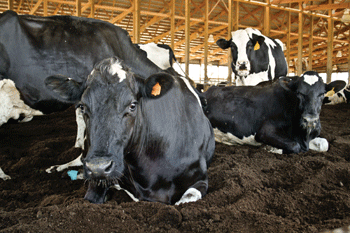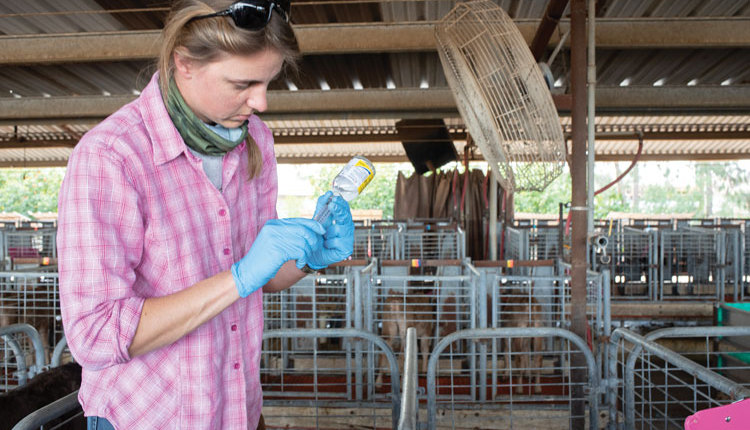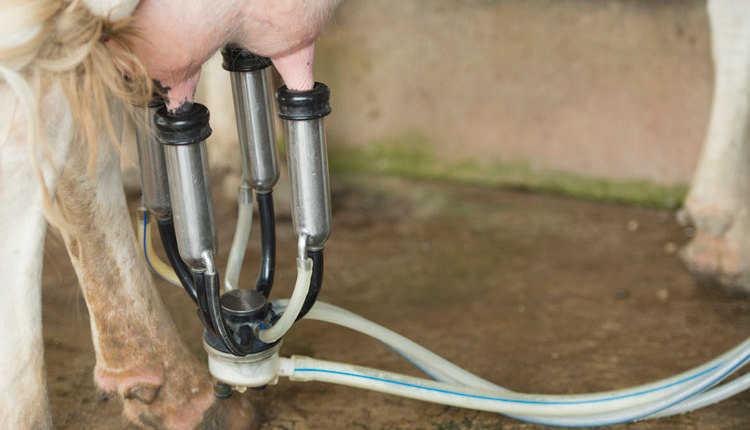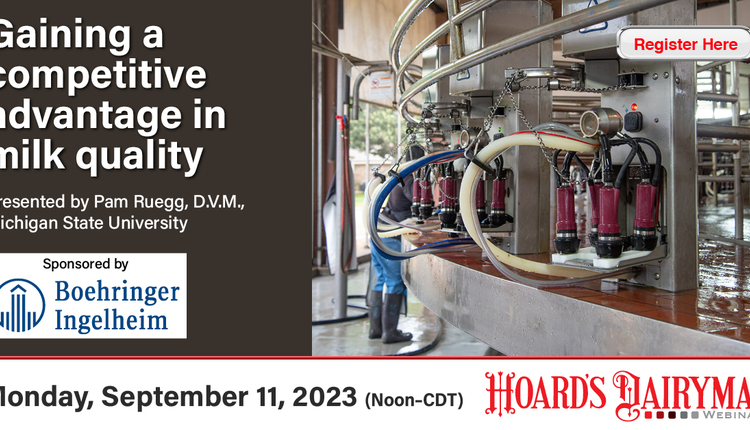The author is a professor and extension milk quality specialist at the University of Wisconsin-Madison.

Dry cow care has a lot to do with how much mastitis we have in our herds, as well as the metabolic problems. Cows are most susceptible to mastitis during the first three weeks of the dry period and right around calving.
For decades, milk quality specialists have recommended using intramammary antibiotic dry cow treatment in every quarter of every cow. Research has shown that use of dry cow therapy cures most intramammary infections present at dryoff and reduces development of new ones during the dry period.
The use of dry cow therapy began as a control strategy for subclinical infections caused by contagious mastitis pathogens (such as Staph. aureus and Strep. ag.). But, more recently, researchers have recognized that many subclinical infections caused by environmental pathogens (environmental streps, coagulase negative staph, coliforms, and so forth) can develop during the dry period.
Chronic subclinical infections (present at dryoff and after calving) and new infections (developed between dryoff and calving) both cause higher rates of both subclinical and clinical mastitis during the next lactation. Some research has shown that cows that develop mastitis infections during the dry period produce less during the next lactation. Other research has demonstrated that the presence of persistent subclinical mastitis during the dry period results in lower production and poor colostrum quality.
Mastitis develops when exposure to bacteria exceeds the ability of the teat end defenses to prevent bacterial infection. Risk factors for development of mastitis during the dry period are similar to those during lactation.
Cows are more susceptible during the first three weeks of the dry period and immediately before calving. Reasons for greater susceptibility during this period include more gland pressure that fosters milk leakage and leads to easier entrance of bacteria through the teat canal; reduced local immune response; and there is no flushing effect of milking on bacteria present in the mammary gland. Since we will no longer forestrip and predip, there is greater growth of and exposure to bacteria on teat skin and in the streak canal. The streak canal becomes shorter during the dry period, and the development of a physical barrier to infection (keratin plug in the streak canal) takes time. There's a strong association between the failure to develop a keratin plug and the development of clinical mastitis.
Higher-producing cows may be at greater risk during the dry period. In cows that produced 46 pounds of milk or more the day before dryoff, more than half still had "open teats" six weeks after dryoff.
What you can do
It is important to identify potential risk factors for the development of mastitis during the dry period and right after calving so you can put in place strategies to reduce the impact of those infections on production during the next lactation. From August 2005 through January 2007, cows in the University of Wisconsin-Madison herd were enrolled in a study to determine the origin of mastitis infections that develop during the dry period and impact of those infections in the next lactation. At dryoff, all cows were dry treated and given an internal teat sealant (Orbeseal).
During the first four months after the enrolled cows calved, 23 percent of the 205 cows that completed the study experienced a clinical case. The cow's age was one of the most important risk factors for developing both subclinical and clinical mastitis. Only 5 percent of cows in second lactation developed clinical mastitis, in contrast to 23 percent of cows in third or greater lactation. Likewise, after calving, the percent of quarters with SCC values that indicate subclinical mastitis (greater than 200,000) was 20 percent of second lactation, 59 percent of third lactation, and 83 percent of fourth or greater lactation.
The mastitis history in the previous lactation was another very important risk factor for development of clinical mastitis in the next lactation. Quarters that had at least one case of mastitis during the lactation before dryoff were more than four times more likely to have a case of mastitis in the next lactation, as compared to quarters of cows that did not have mastitis previously.
UW researchers isolated different pathogens from the clinical cases, as compared to bacteria recovered from the subclinical cases. Coagulase negative staphs were the most common pathogens found from subclinical mastitis cases, while environmental pathogens (Streptococci, E. coli, Klebsiella, and others) were the most common bacteria recovered from clinical cases.
In this study, very few clinical cases seemed to be associated with new infections acquired during the dry period. But more than half of the clinical cases seemed to be caused by bacteria that were acquired during the early postcalving period. And, about one-third of the clinical cases occurred in quarters that seemed to maintain chronic infections across the dry period. These chronic quarters had SCC values greater than 200,000 cells/ml at both dryoff and after calving, even though bacteria were not found in most samples.
Quarters with chronically high SCC were almost three times more likely to have a clinical case of mastitis during the first 120 days of the next lactation. These quarters also were 20 times more likely to have subclinical mastitis caused by a major mastitis pathogen at the first DHI test, as compared to quarters that maintained low SCC values at both dryoff and after calving. More importantly, cows that had high SCC values in quarter milk at both dryoff and after calving produced about 20 pounds less milk at their first test, as compared to cows with quarter milk SCC of less than 200,000 at both periods.
This information supports previous research. First, properly managing dry cows can have a huge influence on whether or not a cow gets mastitis during the next lactation. Second, some cows simply are at greater risk of developing mastitis.
Our advice is
Continue to use dry cow antibiotic treatment for all quarters in all cows. Manage dry cows' environment to reduce exposure to environmental mastitis organisms. Using internal teat sealants is a good option for many herds.
How you house and handle cows right after calving is at least as important as what you do during the dry period. Strive to not overcrowd during this critical period.
A good thumbrule is to not calve cows in areas that you would not feel comfortable lying down in yourself. Do not use the same milking unit to milk cows with mastitis and those that are recently fresh.
A cow's history in the previous lactation appears to be a strong predictor of her mastitis risk. The risk of both clinical and subclinical mastitis appears to be greater if quarter SCC values are high both before and after calving. We need more research to determine effective strategies to reduce this risk. In some cases, it makes sense to dry off quarters. It is likely that management of these cows is specific to each herd, and you should discuss appropriate protocols for dealing with these cows with your vet.

Dry cow care has a lot to do with how much mastitis we have in our herds, as well as the metabolic problems. Cows are most susceptible to mastitis during the first three weeks of the dry period and right around calving.
For decades, milk quality specialists have recommended using intramammary antibiotic dry cow treatment in every quarter of every cow. Research has shown that use of dry cow therapy cures most intramammary infections present at dryoff and reduces development of new ones during the dry period.
The use of dry cow therapy began as a control strategy for subclinical infections caused by contagious mastitis pathogens (such as Staph. aureus and Strep. ag.). But, more recently, researchers have recognized that many subclinical infections caused by environmental pathogens (environmental streps, coagulase negative staph, coliforms, and so forth) can develop during the dry period.
Chronic subclinical infections (present at dryoff and after calving) and new infections (developed between dryoff and calving) both cause higher rates of both subclinical and clinical mastitis during the next lactation. Some research has shown that cows that develop mastitis infections during the dry period produce less during the next lactation. Other research has demonstrated that the presence of persistent subclinical mastitis during the dry period results in lower production and poor colostrum quality.
Mastitis develops when exposure to bacteria exceeds the ability of the teat end defenses to prevent bacterial infection. Risk factors for development of mastitis during the dry period are similar to those during lactation.
Cows are more susceptible during the first three weeks of the dry period and immediately before calving. Reasons for greater susceptibility during this period include more gland pressure that fosters milk leakage and leads to easier entrance of bacteria through the teat canal; reduced local immune response; and there is no flushing effect of milking on bacteria present in the mammary gland. Since we will no longer forestrip and predip, there is greater growth of and exposure to bacteria on teat skin and in the streak canal. The streak canal becomes shorter during the dry period, and the development of a physical barrier to infection (keratin plug in the streak canal) takes time. There's a strong association between the failure to develop a keratin plug and the development of clinical mastitis.
Higher-producing cows may be at greater risk during the dry period. In cows that produced 46 pounds of milk or more the day before dryoff, more than half still had "open teats" six weeks after dryoff.
What you can do
It is important to identify potential risk factors for the development of mastitis during the dry period and right after calving so you can put in place strategies to reduce the impact of those infections on production during the next lactation. From August 2005 through January 2007, cows in the University of Wisconsin-Madison herd were enrolled in a study to determine the origin of mastitis infections that develop during the dry period and impact of those infections in the next lactation. At dryoff, all cows were dry treated and given an internal teat sealant (Orbeseal).
During the first four months after the enrolled cows calved, 23 percent of the 205 cows that completed the study experienced a clinical case. The cow's age was one of the most important risk factors for developing both subclinical and clinical mastitis. Only 5 percent of cows in second lactation developed clinical mastitis, in contrast to 23 percent of cows in third or greater lactation. Likewise, after calving, the percent of quarters with SCC values that indicate subclinical mastitis (greater than 200,000) was 20 percent of second lactation, 59 percent of third lactation, and 83 percent of fourth or greater lactation.
The mastitis history in the previous lactation was another very important risk factor for development of clinical mastitis in the next lactation. Quarters that had at least one case of mastitis during the lactation before dryoff were more than four times more likely to have a case of mastitis in the next lactation, as compared to quarters of cows that did not have mastitis previously.
UW researchers isolated different pathogens from the clinical cases, as compared to bacteria recovered from the subclinical cases. Coagulase negative staphs were the most common pathogens found from subclinical mastitis cases, while environmental pathogens (Streptococci, E. coli, Klebsiella, and others) were the most common bacteria recovered from clinical cases.
In this study, very few clinical cases seemed to be associated with new infections acquired during the dry period. But more than half of the clinical cases seemed to be caused by bacteria that were acquired during the early postcalving period. And, about one-third of the clinical cases occurred in quarters that seemed to maintain chronic infections across the dry period. These chronic quarters had SCC values greater than 200,000 cells/ml at both dryoff and after calving, even though bacteria were not found in most samples.
Quarters with chronically high SCC were almost three times more likely to have a clinical case of mastitis during the first 120 days of the next lactation. These quarters also were 20 times more likely to have subclinical mastitis caused by a major mastitis pathogen at the first DHI test, as compared to quarters that maintained low SCC values at both dryoff and after calving. More importantly, cows that had high SCC values in quarter milk at both dryoff and after calving produced about 20 pounds less milk at their first test, as compared to cows with quarter milk SCC of less than 200,000 at both periods.
This information supports previous research. First, properly managing dry cows can have a huge influence on whether or not a cow gets mastitis during the next lactation. Second, some cows simply are at greater risk of developing mastitis.
Our advice is
Continue to use dry cow antibiotic treatment for all quarters in all cows. Manage dry cows' environment to reduce exposure to environmental mastitis organisms. Using internal teat sealants is a good option for many herds.
How you house and handle cows right after calving is at least as important as what you do during the dry period. Strive to not overcrowd during this critical period.
A good thumbrule is to not calve cows in areas that you would not feel comfortable lying down in yourself. Do not use the same milking unit to milk cows with mastitis and those that are recently fresh.
A cow's history in the previous lactation appears to be a strong predictor of her mastitis risk. The risk of both clinical and subclinical mastitis appears to be greater if quarter SCC values are high both before and after calving. We need more research to determine effective strategies to reduce this risk. In some cases, it makes sense to dry off quarters. It is likely that management of these cows is specific to each herd, and you should discuss appropriate protocols for dealing with these cows with your vet.











